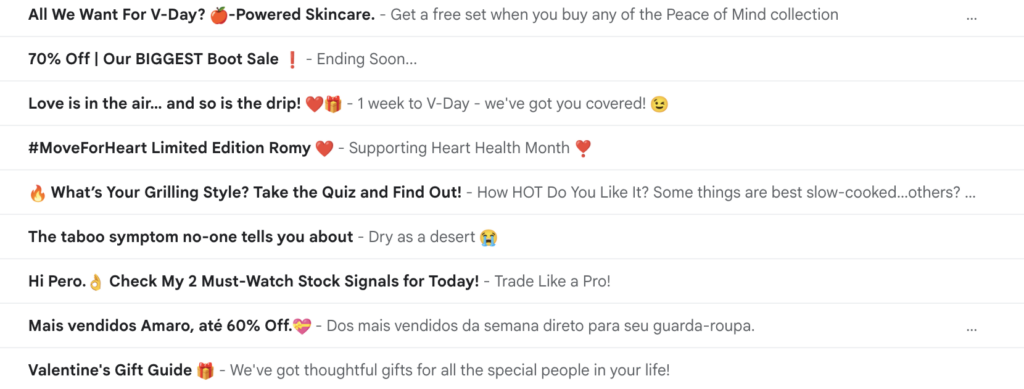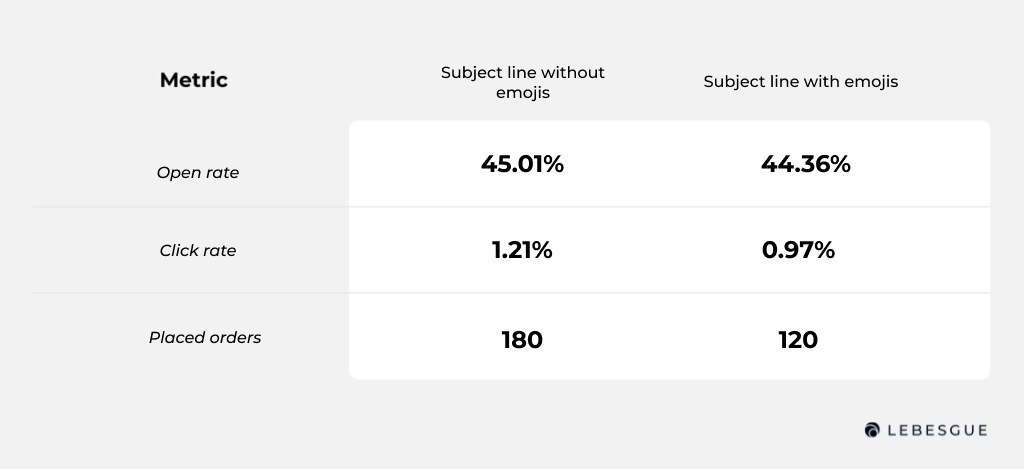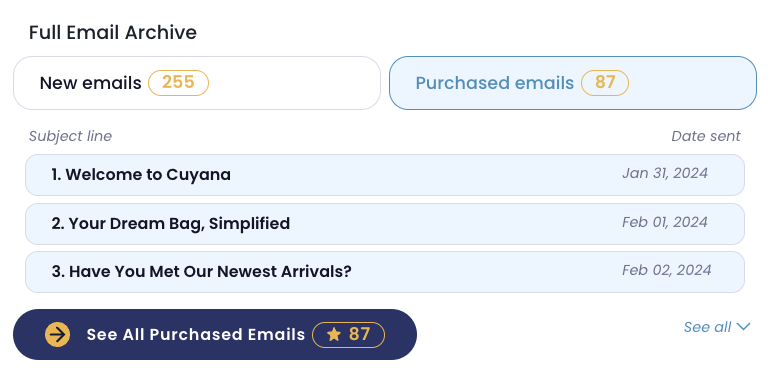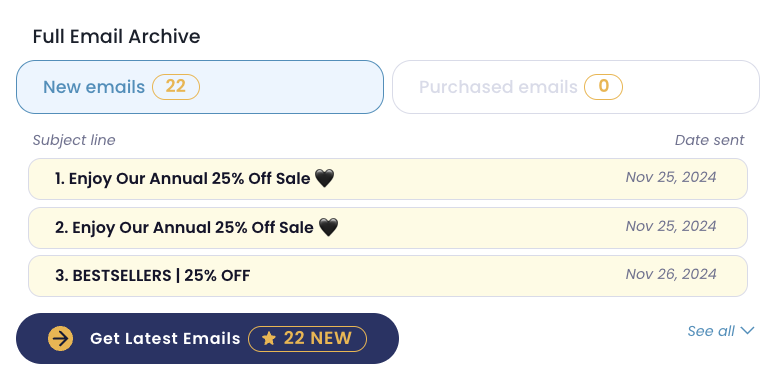Emojis in email subject lines have been a hot topic among marketers for years. Many believe that adding a 🔥 or 🚀 can grab attention and boost open rates. But do emojis really make a difference, or are they just a gimmick?
To find out, we ran an A/B test—one version of our subject line included an emoji, while the other did not. The results were surprising: emails without emojis performed better.
In this blog post, we’ll break down the test, analyze the data, and explain why avoiding emojis in subject lines might be the smarter choice.
Why Marketers Use Emojis in Subject Lines
Many marketers believe that adding emojis to subject lines can improve email performance. The idea is that emojis help emails stand out in crowded inboxes and make subject lines more engaging. Here are the key reasons why brands use them:
- grabbing attention,
- adding personality and emotion, and
- improving readability and saving space.
With hundreds of emails competing for attention, marketers look for ways to make their subject lines visually distinct. Since emojis introduce color and shape variations, they can break the monotony of text-heavy inboxes. The assumption is that this increased visibility leads to higher open rates.
Emojis are often seen as a way to convey emotion and brand personality quickly. Instead of relying solely on words, brands use emojis to communicate excitement, urgency, or playfulness. For example, a fashion brand promoting a new collection might use an emoji to create a sense of excitement, while a travel company might use one to evoke feelings of adventure.
Since subject lines have character limits, marketers sometimes use emojis as a shorthand for certain words or concepts. A food delivery service, for instance, might use an emoji instead of spelling out a type of cuisine. This approach is meant to make subject lines easier to scan and understand at a glance.
Do Emojis Actually Make Emails Stand Out?
As discussed previously, one of the main reasons marketers use emojis in subject lines is to grab attention in a crowded inbox. The assumption is that adding an emoji makes an email visually distinct, increasing the chances of it being opened. But does that really happen?
Looking at the email examples in the images below, a different pattern emerges. Many brands are using emojis, sometimes even in similar ways. Instead of making an email unique, emojis have become so common that they blend in rather than stand out.
When multiple emails in an inbox contain emojis, their impact is significantly reduced.

So, while the idea of emojis making subject lines pop sounds appealing, in reality, they often contribute to the noise rather than cutting through it. The question then becomes: Are emojis actually improving performance, or are they just a marketing habit? That’s what we set out to test.
Adding Emojis In Subject Lines Improves Open and Click Rates
Marketers often assume that adding emojis to subject lines can boost email performance in two key ways:
Higher Open Rates – The belief is that emojis grab attention and make emails stand out, leading to more people noticing and opening them. Since subject lines are one of the biggest factors influencing open rates, the assumption is that a well-placed emoji can make a measurable difference.
Higher Click-Through Rates – Some argue that emojis set a tone for the email’s content, making it more engaging. If an email feels more personal or visually appealing in the inbox, recipients might be more likely to interact with it.
This thinking is reinforced by past studies suggesting that emails with emojis sometimes outperform those without. However, marketing trends evolve, and what worked a few years ago may not hold true today—especially as more brands adopt the same strategy.
To put this assumption to the test, we ran an A/B experiment comparing subject lines with and without emojis. Let’s see the results!
The A/B Test: Do Emojis Improve Open Rates?
To determine whether emojis positively impact email performance, we ran an A/B test with the following setup:
- Version A: Subject line without an emoji
- Version B: The same subject line but with an emoji added
- Both emails had identical content, layout, and preview text—the only difference was the inclusion of an emoji in the subject line.
We tracked three key metrics:
- Open Rate – The percentage of recipients who opened the email
- Click-Through Rate (CTR) – The percentage of recipients who clicked a link inside the email
- Placed Orders – The percentage of recipients who completed a purchase after clicking
The Results: Do emojis help or hurt performance?
- Open Rate: Emails without emojis had a 1.5% higher open rate than those with emojis. While this difference isn’t significant, it shows that emojis didn’t help increase visibility in a crowded inbox.
- Click-Through Rate: The email without an emoji had a 25% higher CTR, meaning recipients were more likely to engage with the content and click on links.
- Placed Orders: The most significant difference was in conversions. Emails without emojis led to 50% more placed orders and a 90% higher value of placed orders compared to emails with emojis.

These results suggest that while emojis may grab attention initially, they might actually reduce engagement and conversions once recipients open the email.
So, while the open rate difference is small, the more substantial increase in clicks and placed orders with emails without emojis tells a different story.
Analyze Your Competitors' Email Strategies with Lebesgue AI CMO
One of the most powerful features of Lebesgue AI CMO is the ability to monitor your competitors’ email campaigns—not just the frequency and content, but also the subject lines.
This insight allows you to understand how your competitors are creating their emails and whether they’re using strategies like emojis in their subject lines.


By analyzing competitor subject lines, you can:
- Assess Emoji Usage: See if competitors are incorporating emojis and how often, giving you an idea of whether this is a trend worth exploring in your own campaigns.
- Evaluate Email Strategy: Understand how competitors approach email content, timing, and structure, which can help you align or differentiate your own campaigns.
- Make Data-Driven Decisions: With this detailed overview, you can test whether emojis in your subject lines will benefit your email performance or if your competitors’ strategies are already reflecting what works best.
Whether you want to follow industry trends or stand out with a different approach, Lebesgue AI CMO offers the insights you need to fine-tune your email strategy, test new ideas, and stay ahead of the competition.
Summing Up
In our test, the data showed that emails without emojis outperformed those with emojis in terms of open rates, click-through rates, and conversions. While emojis may initially seem like an effective strategy for standing out in crowded inboxes, our results suggest they might not always deliver the desired impact.
That being said, every business is different. What works for one brand might not work for another. We recommend that you test emojis in your own email campaigns to see how they affect your specific audience.
With tools like Lebesgue AI CMO, you can track and analyze your results, refine your strategy, and make data-driven decisions to find the best approach for your business.

